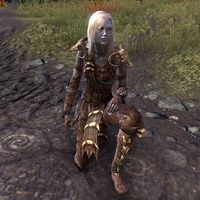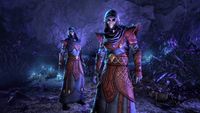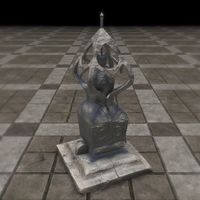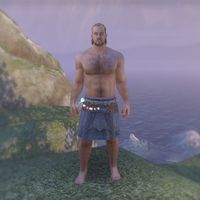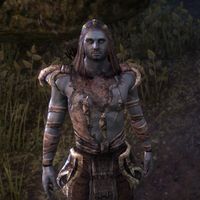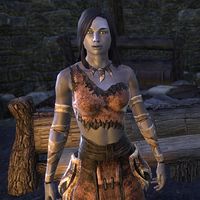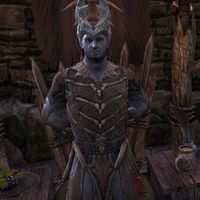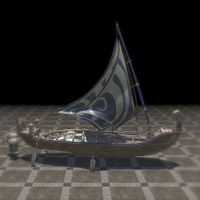Lore:Kothringi
The Kothringi (or Lustrous Folk)[1] are a silver-skinned[2] tribal people indigenous to Black Marsh who are believed to be descendants of the Nedes.[3] Once considered the only humans native to Tamriel, they are now known to have shared the continent with many other tribal groups.[4] The race was believed to have been driven to extinction by the Knahaten Flu in the Second Era.[5]
History[edit]
The presence of the Kothringi in Black Marsh predates the most ancient records. They are believed to descend from the Nedic people.[3] According to some sources, Kothringi culture started in the early Merethic Era, or even before that time.[6][7] In the ancient past Kothringi and Argonians of the Hissmir warred against each other. Argonians feared that Kothringi could use the power of Zaht stones against them. Little is known of the outcome of this conflict, but Hissmir remained an Argonian settlement.[8][9]
The Kothringi were thought to have been avid sailors, sailing as far as Hammerfell, possibly spreading the Knahaten Flu of 2E 560 to Valenwood and nearby provinces by ship. Kothringi shipbuilding is said to be very idiosyncratic with one example having unusual paddle placement, shallow draft, and a sail. Some vessels were capable of navigating both swamps and coastal waters due to this.[10]
The Kothringi were thought to be exterminated by the Knahaten Flu,[5] although some of the infected fled on the Crimson Ship westward, away from Tamriel, never to be seen again.[11] However, legends tell of those who supposedly saw the ship and never lived to tell the tale.[12]
Despite the widespread belief of the race's extinction, several Kothringi survived the Flu through unnatural means. In 2E 561, the chief of Stillrise Village, a Kothringi settlement in Shadowfen, entered into a desperate pact with Clavicus Vile in order to survive the disease.[13] The Daedric Prince kept his end of the bargain, but did so by transforming the populace into immortal, undead skeletons.[13] The villagers maintained appearances through illusion magic, but their secret was discovered in 2E 582 when the Order of the Black Worm attempted to enslave the undead inhabitants.[13][14] The villagers successfully repelled the necromancers, but infighting broke out, and it is unknown if they chose to destroy the curse or continue living as skeletons.[15] In the nearby town of Zuuk, a lone Kothringi man named Drillk became immune to the Flu by absorbing the power of a keystone.[16][17] He became a person of interest to the Aldmeri Dominion and the Ebonheart Pact in 2E 582, when both sides sought to acquire the keystone.[18] An agent of the Ebonheart Pact rescued Drillk from the Dominion invaders, but the Kothringi revealed that taking the keystone's power would kill him.[17] It is unknown if the Pact soldier accepted his keystone or not.[19]
Some Kothringi are known to have survived the events of Stillrise Village by serving the Ideal Masters.[20]
Circa 2E 582, a member of the University of Gwylim's Antiquarian Circle tracked down and discovered pieces of a magical Kothringi hunter's garment, putting it back together.[21]
Society and Culture[edit]
Little detail is known about the Kothringi. They generally preferred to go naked, although a few wore clothes when outside their native land.[2] They appear to have worshipped a god named Z'en—a God of Toil—[22] as well as Dibella,[23][1] Mara, and Kynareth.[UOL 1] It was believed that at some point of the history Kothringi venerated Clavicus Vile, before shifting to Z'en worship.[7]
Music was very important in Kothringi society. They were known to make instruments out of a variety of different materials, such as turning hollow logs into wamasu-sized drums, plucking sinew from cliff striders to make low humming bow harps and most notable of all, their chimes known to be the Kothringi's most loved instruments. A Kothringi by the name of Baelah molded hundreds of chimes from tin and copper, hanging them from branches and striking them for their sounds. The Kothringi sometimes invited the Saxhleel for feasts and celebrations where they played their instruments for the Argonian people.[24][25] It is believed that cultural exchange between Kothringi and Argonians took place.[6] Circa 2E 582, the Bards College in Solitude came into possession of a Kothringi bugle created from the horn of a leviathan.[26] Around the same time, the Thieves Guild also stole a sacred Kothringi shovel, believed to be a blessed instrument of Z'en, from Stormhold.[27][28] Kothringi Humming Dolls were toys that featured a clever arrangement of air bladders and reeds inside and hummed when squeezed.[29]
Some considered the Kothringi peerless crafters,[30] despite their distaste for clothing. They also occasionally crafted pieces of armor.[31] They might've been capable of difficult crafting feats such as weaving strands of metal into cord in order to create stronger nautical rope.[25] Kothringi spellcraft is considered unusual to the point that an experienced mage may miss its presence. Some Kothringi magic would possibly heighten the target's senses or reflexes.[25]
Kothringi utilized throwing knives, axes and harpoons in combat.[25][8]
Portable Kothringi abacuses employed varnished sphere-scarabs as slide-beads.[32] Kothringi artisans perfected a technique for weaving reeds of different colors and textures into decorative mats.[33] Dream catchers crafted by Kothringi could be found around Tamriel during the Interregnum.[34]
Kothringi folklore mentions "geels-ha butcher eels", massive river predators capable of swallowing haj mota whole. They would obtain bog-blue jaspers from these eels to use in fetishes.[25]
Kothringi knights made up a large part of the imperial garrison of Gideon, and Empress Tavia, wife of Reman III, the last ruler of the Reman Dynasty, had a Kothringi knight named Zuuk with whom she conspired to assassinate her husband.[2] After Reman III was assassinated, "Lord" Zuuk returned to Shadowfen and founded a town which was eventually named after him.[35] The Kothringi buried their dead in cairns, often adorning these burial sites with glass beads. Some glass beads were also worn, serving as wearable instruments.[25] Some residents of Gideon claim that Kothringi spirits linger in the town.[36] Fortune hunters sometimes poked around Gideon, searching for lost Kothringi treasure.[37]
Kothringi utilized moonstone in their artwork and handicrafts, such as their statues.[38]
Gallery[edit]
Notes[edit]
- Kothringi Soul Shriven were used in the construction of the Great Shackle in Coldharbour.[39]
- "Betrux" means "open" in the Kothringi language.[17]
- The Kothringi may be related to the Kothri, a Nedic tribe herded as slaves by the Ayleids in the early First Era.[40]
See Also[edit]
- Kothringi Names
- For a list of notable Kothringi, see here.
- For game-specific information, see the Elder Scrolls Online article.
References[edit]
- ^ a b Augustine Viliane Answers Your Questions — Sibyl Augustine Viliane
- ^ a b c 2920, Morning Star — Carlovac Townway
- ^ a b Lodyna Arethi's dialogue during King of Dust in ESO
- ^ Lost Valley Redoubt's loading screen in ESO
- ^ a b Pocket Guide to the Empire, 1st Edition: The Wild Regions — Imperial Geographical Society, 2E 864
- ^ a b Nest of Shadows antiquity codex description
- ^ a b Silver Wish Medallion antiquity codex text
- ^ a b The True Balance
- ^ Awas' dialogue in ESO
- ^ Kothringi Tidal Canoe codex entries in ESO
- ^ The Daggerfall Chronicles — Ronald Wartow
- ^ Pirates of the Abecean
- ^ a b c Chieftain Suhlak's dialogue during The Thin Ones in ESO
- ^ Events of The Thin Ones in ESO
- ^ Events of The Bargain's End in ESO
- ^ Morilye's dialogue during Into the Temple in ESO
- ^ a b c Drillk's dialogue during Into the Temple in ESO
- ^ Events of King of Dust in ESO
- ^ Events of Into the Temple in ESO
- ^ Stillrise Ritecaller description in ESO
- ^ Harpooner's Wading Kilt in ESO
- ^ Varieties of Faith... — Brother Mikhael Karkuxor of the Imperial College
- ^ Traveler's Guide to Gideon — Astinia Isauricus; Published 22 Frost Fall, 2E 570
- ^ Chimes of Silver — Geem-Shah, Singing Mouth of the Naka-Desh Tribe
- ^ a b c d e f Harpooner's Wading Kilt's codex entries in ESO
- ^ Kothringi Leviathan Horn
- ^ Kari's Hit List in ESO
- ^ Shaman Chirah's Devotion Shovel item description in ESO
- ^ Kothringi Humming Ball itm description in ESO
- ^ Harpooner's Wading Kilt's description in ESO
- ^ Kothringi Plate Pauldrons
- ^ Kothringi Abacus from Zuuk item description in ESO
- ^ Kothringi Six-Reed Mat item description in ESO
- ^ Kothringi Dream Catcher item description in ESO
- ^ The Founding of Zuuk — Ashalaku, Black Marsh
- ^ Dexion Asellus' dialogue in ESO
- ^ Madarah's dialogue in ESO
- ^ Moonstone Kothringi Maiden's item description in ESO
- ^ The Black Forge — Kyngald Nazkrixor
- ^ The Adabal-a — Morihaus
Note: The following references are considered to be unofficial sources. They are included to round off this article and may not be authoritative or conclusive.
| |||||||||||||||||||||||||||||||||||||||||||
